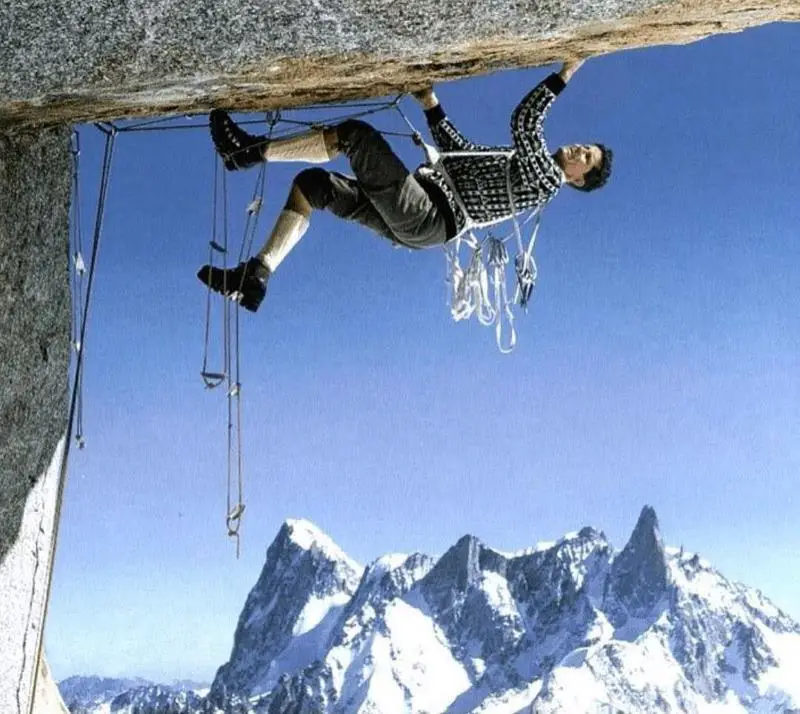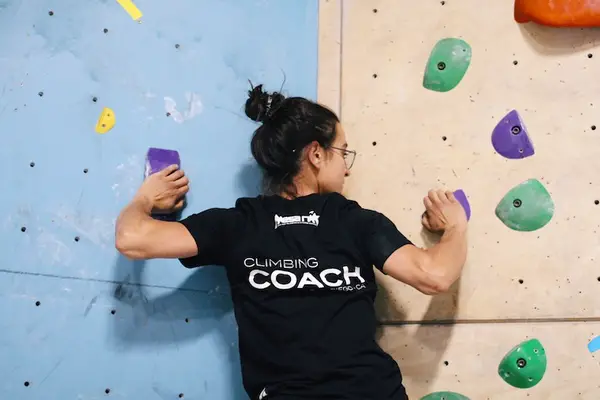In the intricate world of rock climbing, the term “gaston” might sound foreign to many, but it’s a technique you’ll most definitely come across at some point in your climbing, whether that’s indoors or outdoors.
The gaston is a unique climbing move where climbers use their arms and palms to push outwards, as opposed to the conventional pulling motion towards the body. This technique involves positioning the palms facing out with the thumbs pointing downwards. Imagine trying to pry open elevator doors from the middle; that’s what a gaston move feels like.
Why Is It Called ‘Gaston’?
This has nothing to do with the charming Beauty & The Beast character, Gaston. In fact, Gaston was the name of a French alpinist back in the day. Gaston Rébuffat was an accomplished mountaineer, having climbed all 6 north faces of the Alps. He was also part of the first expedition to Annapurna, and although he didn’t make it to the summit, it was the highest anyone had been at the time.

This is all very interesting, but what is the actual gaston climbing origin? Gaston Rébuffat was photographed doing this move and since then it’s been known as the gaston technique.
What Is A Gaston Climbing Move?
I briefly touched on what a gaston move is, but let’s go over it in more detail. In its simpler form, gaston climbing is when you have two holds that require you to bring your elbows out and your thumbs facing down, just like prying open an elevator door. With a gaston, you are pushing force outwards and your hands tend to be pretty close to your face (but not always).

The complexity of a gaston can vary. At beginner levels, you might encounter straightforward gastons where both holds are of equal size and comfortably close to your face. However, as you advance in your climbing journey, be prepared for more intricate gastons. These might involve holds of varying sizes, positioned at different heights or distances, with one arm potentially reaching higher and farther from your face than the other.
How To Identify A Gaston Hold
A gaston isn’t identified by the hold but by the position of the hold. You might have to gaston on two crimps, or slopers, or on two edges. It’s the way that those holds are positioned that determines the gaston. If the positive edge of the hold is facing towards you, then you’ll most likely need to gaston.
The hallmark of a gaston is when the positive edge of the hold, the part that juts out and offers grip, faces towards you. This orientation prompts climbers to adopt the distinctive outward pushing motion, akin to prying open elevator doors. Typically, you’ll encounter gastons in scenarios where there are two opposing holds or when holds are diagonally aligned. When executing a gaston, your elbows flare out, aligning roughly at shoulder height, while your thumbs point downwards.

The spatial arrangement of the holds plays a pivotal role in the complexity of the gaston. Sometimes, the holds are close and similar in size, making the move relatively straightforward. However, as routes become more challenging, the holds might differ in size and position. In some cases, one hold might be higher and farther from your face than the other, demanding greater dexterity and strength.
The gaston technique is not just about the hands. Footwork plays a pivotal role in executing this move effectively. As you engage in a gaston, your feet often point outwards, providing the necessary stability and balance. This outward foot positioning helps counteract the outward force exerted by the hands, ensuring you remain anchored to the wall.
Gaston climbing is a lot more obvious when the holds are big. If the holds are smaller, you might not realize it’s a gaston until you do the move, but your body will know exactly what to do.
Do You Get Gaston Bouldering?
Gastons are versatile climbing moves that can be found across various climbing disciplines, both indoors and outdoors. Indoor bouldering, especially in modern competition-style routes, frequently features gaston techniques, but they’re by no means exclusive to this setting.

Outdoor climbing presents its own set of challenges and opportunities for gastons. For instance, in off-width climbing, a type of crack climbing where the fissure is too wide for a hand jam but too narrow for a full body wedge, gastons can be crucial. They allow climbers to reposition themselves or gain leverage in these tricky terrains.
Additionally, sport climbing routes, both indoor and outdoor, might incorporate gastons to navigate overhangs or traverse sections. Trad climbing, with its unpredictable natural routes, can also present scenarios where a gaston becomes the most efficient move.
In essence, wherever there’s a need for an outward pushing motion against holds, be it in the controlled environment of an indoor gym or the rugged terrains outdoors, the gaston technique comes into play.
How To Train For Gaston Climbing
Gaston moves are undeniably shoulder-intensive, demanding both strength and technique. To master this move, a combination of specific climbing drills and general fitness exercises is essential.
Climbing-Focused Training
Consistent Practice: The most straightforward way to get better at gastons is to climb regularly. Seek out routes in your climbing gym that incorporate gaston moves and practice them repeatedly.
Spray Wall Drills: Utilize a spray wall to design your own routes, emphasizing gaston moves. Regularly practicing on these self-created routes a few times a week will not only bolster your shoulder and back strength but also instill muscle memory. This ensures that your body instinctively knows how to maneuver when confronted with a gaston challenge.
Lattice Board Workouts: If your climbing gym has a Lattice Board, it’s a valuable tool. This adjustable training board can be tailored to simulate various climbing scenarios, including gaston moves. Regular training on it can significantly enhance your gaston climbing prowess.
Regular Gym Workouts
For those who also frequent a regular gym, there are specific exercises that can help improve the muscles used in gaston moves:
Shoulder Strengthening: Incorporate exercises like shoulder presses, lateral raises, and front raises to target the deltoids.
Rotator Cuff Exercises: The rotator cuff plays a pivotal role in stabilizing the shoulder during gaston moves. Exercises like internal and external rotations using resistance bands or light dumbbells can be beneficial.
Push-Ups: A classic exercise, push-ups engage the chest, triceps, and shoulders, all of which are crucial for gaston moves.
Wide Planks: Holding a wide plank position, can help strengthen the core and shoulders simultaneously.
Plyometric Push-Ups: These explosive push-ups can help develop power in the shoulders, which can be beneficial for forceful gaston moves.



